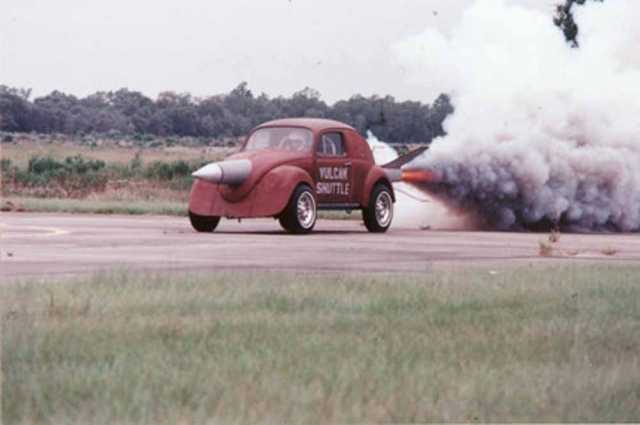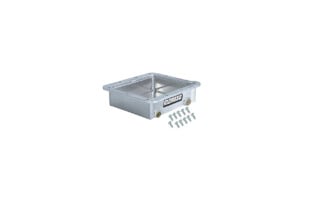Racing is all about innovation. Or at least, it used to be. When American G.I.s came back from Europe after “The Big One”, hot rodding became a cultural phenomenon, and guys that were used to seeing little Italian sports cars and German luxury wagons came back to their ‘40s Fords and Dodges and started tinkering in a big way.
They say that the first auto race happened the day the second guy in town got a car, and that’s probably true. And from that day on, people started hot rodding, eventually culminating in the white-hot NHRA drag racing scene of the ‘50s and ‘60s. There weren’t very many rules back then, which allowed guys to experiment with some truly radical designs. Some worked, some didn’t, and some killed their revolutionary inventors. But for every failed drag car design, something was learned, for better or for worse.
In this list of 10 cars that didn’t work, you’ll see a few names pop up more than once. That’s no knock against them; it’s a testament to their ingenuity, their courage, and frankly, the size of their balls to think outside the box of conventional thinking. We salute them, while we also point out where they got it wrong.
The Vulcan Shuttle
A lot of racers have tried to harness the uncontrollable power of a rocket engine, some better than others. You see, the problem with a rocket in a drag racing situation is that the length of time that thrust is being created is directly proportional to the amount of solid fuel in the tank. The driver is not controlling the throttle; that’s the job of physics. We’re not talking about a turbine here, like that used in a jet airliner – those have on/off switches. A rocket? Not at all. You light the fuse and hang on for however long it decides to burn. And that’s why a lot of guys have been killed driving rocket cars. The Vulcan Shuttle came out in around 1980 or so, a rocket motor housed in a Volkswagen. Yeah, it sounds stupid to us writing this 30 years later. With a surplus engine that was about 10-feet long, this little Bug acted like an out-of-control bottle rocket, and eventually killed its driver, Rodney Poole, during a test pass at an airport.
The Sidewinder

Photo courtesy of the Don Garlits Museum of Drag Racing
Don Garlits –you know him as Big Daddy — has been around drag racing for as long as it’s mattered. Enduring through Wally Parks’ Fuel Ban in the ‘60s, Big has had his share of innovations when it comes to getting down 1,320 feet of asphalt quicker than the next guy. Some worked, and some didn’t, but you can never fault the man for trying something different.
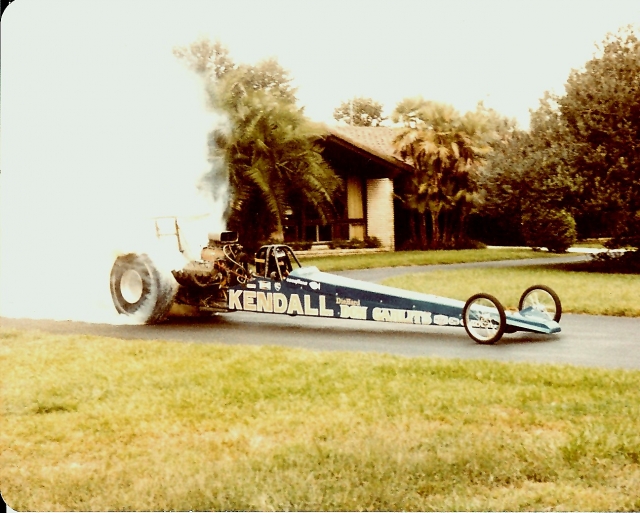 Don Garlits Museum of Drag Racing" width="640" height="513" />
Don Garlits Museum of Drag Racing" width="640" height="513" />Swampt Rat 27 prior to the sidewinder engine experiment. Photo courtesy of the Don Garlits Museum of Drag Racing
The Sidewinder Top Fuel Dragster, known as Swamp Rat 27, of the mid-‘80s looked like one that would work, but it didn’t. The idea was to mount the engine sideways, so that the natural torque (rotational) force of the engine would apply traction to the rear tires. The problem was transferring the power to the tires. Mike and Chuck Sage, with Russ Camp, developed a gearbox that drag racing historian Bret Kepner described as “a masterpiece,” but the car just never worked up to Big’s expectations. Constant breakage, often thought coming from the axles and not the gearbox, were the car’s Achilles’ heel.
The Funny Vega
Gary Gabelich is best known for his land speed heroics at the Bonneville Salt Flats, but before he became famous there, he was a drag racer, and his greatest FUBAR was a rear-engine, all-wheel-drive, Vega Funny Car. Car Craft did a cover story on the car, and we’ll let them tell it again, ”This month’s cover car represents one of the best-kept secrets of recent drag-racing history. Even in Southern California, few people were aware that a Chrysler-powered, rear-engined, four-wheel-drive, monocoque, Vega panel truck was under construction. Even with the rumors that circulated, few people knew the who, why, and where of the unique undertaking. Now the car is finished and ready for its driver, Gary Gabelich, the ‘fastest man on wheels.'”
This particular car began to evolve during a discussion between Bob Kachler and Kenny Youngblood at Kachler’s Racing Graphics offices in Long Beach, California. Ideas developed into drawings, and soon chassis-builder Paul Sutherland had become involved, bringing with him Al Willard, a friend and engineer who had helped design the highly innovative and successful Ti-22 titanium Can-Am car.
All that was left was to find someone with some money and an interest in the project. That person was Gary Gabelich, holder of the World’s Land Speed Record at over 600 mph, a record achieved at the Bonneville Salt Flats in a rocket-powered vehicle.
Drag racing is nothing new to Gabelich. He has piloted both Top Fuel dragsters and Funny Cars, including the Beach City Corvette. He was also a test subject for the astronaut’s life support systems—space suits and ejection equipment—for the Apollo moon program. Now, following his success at Bonneville, Gary wanted to try his hand at drag racing again. And, in a unique fashion.
Gary’s car couldn’t be much more unique at the present time. Currently there are no single-engine, four-wheel-drive cars on the drag strips. Nor are there any monocoque vehicles (Mickey Thompson’s monocoque Mustang has long since been retired). There are only a handful of rear-engined Funny Cars, and none that can be considered successful. There are no Vega panel trucks. And, certainly, there is no other car that has as distinctive an appearance.
The car’s construction was handled by Paul Sutherland at his Race Car Works from plans produced by himself and Al Willard. Since the entire concept of the car is so unusual, there is a minimal number of parts that are already in existence that are adaptable to this particular design. For this reason, the cost of the car is slightly higher than the average Funny Car.
I think the Gabelich Vega is probably the biggest conglomeration of bad ideas ever in a Fuel car. – Brian Lohnes
The short story is that he debuted the Vega in front of the media in Southern California, intending to do a burnout and a short squirt of throttle, but adrenalin got the better of him and he decided to make a full pass…which resulted in a bad crash and nearly a severed hand in the process. As Bangshift.com’s resident drag racing historian Brian Lohnes said, “I think the Gabelich Vega is probably the biggest conglomeration of bad ideas ever in a Fuel car. It combined the trifecta of four-wheel-drive, rear-engine Funny Car, and a monocque chassis. That and wrecking on the day one of the PR shoot.”
Garlits’ Mangler
Garlits’ “Foot Chopper.” It’s one of the most famous drag racing photos ever taken, of Don Garlits’ clutch explosion that cost him half of his foot. Again, thanks to Brian Lohnes: “Garlits’ dragster that took his foot had a transmission in it called the Garlits-Drive. It was a two-speed planetary transmission that was actually an underdrive. In the days before slipper clutches it was going to be a crude attempt at limiting wheel-spin and maxing acceleration off the starting line. He and T.C. Lemons did not get enough oil into the transmission, and the oil was what kept the drum for over-speeding. With not enough oil, the drum oversped and that’s what caused the transmission to blow up.” Ouch.
The Vacuum Cleaner
Pete Robinson’s series of “Tinker Toy” dragsters were some of the most innovative cars in the history of drag racing. He had one that launched off jacks on the starting line, one that ran an automatic transmission, and other revolutionary differences. But the one that killed him ran what looked to have a big squeegee under it. This was actually an air dam, and Robinson apparently understood aero more than anyone back then. It sucked the car right down onto the track, but it worked too well. On a lap at the ’71 Winternationals, the front wheels came off the rims (presumably because of how hard they were being sucked down onto the track) and he crashed, fatally.
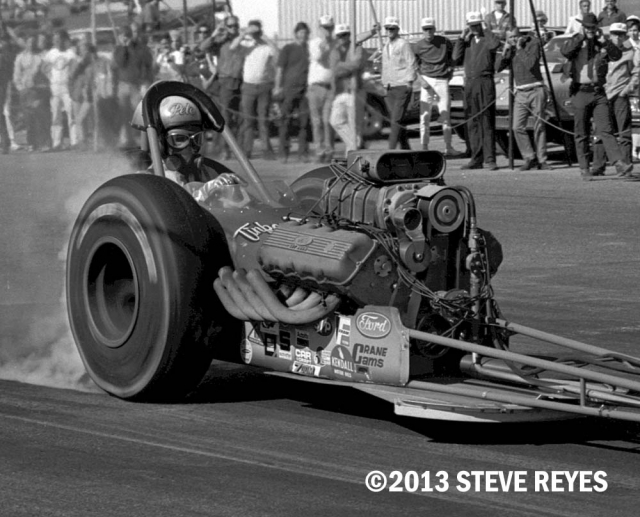 Another Robinson innovation that could have changed the entire “science” of drag racing was his vacuum cleaner. Pete was a strong proponent of light car weight, believing it was easier to accelerate a lighter mass. He knew if the tires could be made to “think” his car weighed 2,500 pounds, rather than 1150, the tires would have far more traction. The car would perform better, providing, of course, that he only had to accelerate 1,300 pounds of car and driver down the track.
Another Robinson innovation that could have changed the entire “science” of drag racing was his vacuum cleaner. Pete was a strong proponent of light car weight, believing it was easier to accelerate a lighter mass. He knew if the tires could be made to “think” his car weighed 2,500 pounds, rather than 1150, the tires would have far more traction. The car would perform better, providing, of course, that he only had to accelerate 1,300 pounds of car and driver down the track.
After a lot of thought he came up with the “vacuum cleaner” concept. Attached between the frame rails was a piece of 15-inch wide by 4-foot long panel of honeycombed aluminum, parallel to the ground, directly under the engine. Then he fastened rubber “curtains” extending down from the panel, perpendicular to the track, around its circumference. They just brushed against the asphalt, making a closed chamber under the car. Then he built a piece of oval cross section aluminum tubing, one end of which fit snugly into the mouth of the Enderle injector atop his blower, extending forward. The tubing then curved down 90 degrees directly in front of the blower drive, with the other end scaled into a hole cut in the top of the chamber. Start the motor and you’ve got a chamber under the car sucking it down. The whole thing didn’t weight 25 pounds. To regulate the amount of air that was sucked from beneath the car (since volume of air passing through the motor gets astronomical as a function of increasing RPM) he put a flapper door in the air tube between the injectors and the chamber. It had an adjustable spring to open when the suction beneath the car became too much, admitting air into the blower from the normal atmosphere without drawing it from beneath the car.
During private testing he had some sorting out problems. The vacuum device sucked the car down so hard the rubber curtains were folding over and dragging against the asphalt. But it worked. As soon as NHRA heard about it, they banned it. Understand this was months before Roger Penske and Mark Donahue did the same thing with their Can Am Porsche that flat ran away from all the other sports cars until the SCCA banned vacuum devices on race cars.
TV Tommy Ivo’s 4-Engine Car
You may be questioning why an exhibition car is on this list, but it didn’t originate as an exhibition machine; he meant the car to be competitive. Your author is honored to live a mere three blocks from TV Tom and has talked to him many times about this car. It was originally built as a dragster, without the station wagon body that you recognize it with today, but it was just too heavy to be competitive in Top Fuel. Still, it continued to solidify Tommy Ivo as the showman he still is today.
Garlits Again
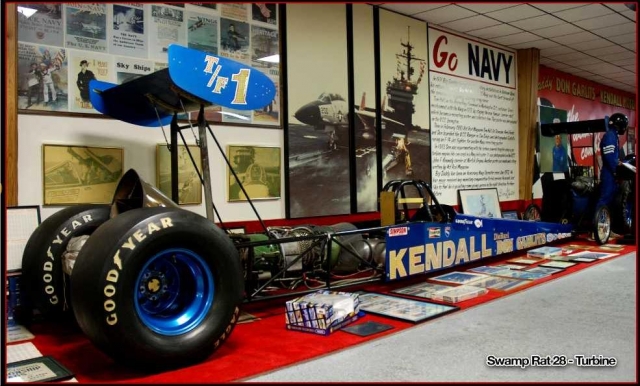
Photo courtesy of the Don Garlits Museum of Drag Racing
Back in the Space Age, when The Jetsons were on TV, everybody was crazy about turbine engines, and drag racers were no different. Once again, Don Garlits dipped his toes into the fray and built a turbine-powered dragster in the very early ‘80s. When the top cars were running 6-flat e.t.s, or high-5s, Big’s jet was only in the mid-6s and didn’t work. The crowd also hated it, since it didn’t thunder the stands, and their guts, like the nitro cars did.
Jocko’s Fantasy
Jocko Johnson may have been the smartest man that ever lived. Unfortunately, he was also one of the craziest. A certified nutcase, he built perhaps one of the most scientific cars to ever go down a drag strip, at least in the late-‘50s and early ‘60s. His streamliner was the quickest car in the world in 1959 and ran in the 180 mph zone, but when technology progressed and Fuel cars started running a lot faster than that, the car liked to fly. Don Garlits, a frequent player on this list, stuck a Fuel-burning Chrysler Hemi under that aero body (as opposed to the huge and heavy V-12 Allison aircraft engine in the original car) and spent an entire year running a short-wheelbase dragster (175 inches compared to 225 inches) to learn how to control the shorty. It didn’t work. With that speed and at that power level, Garlits declared it un-driveable. It’s in his Ocala, Florida Drag Racing Museum today. The original Jocko car still makes appearances at the Bonneville Salt Flats every now and then.
Little Red Wagon
Another exhibition car that went on to be famous for not was it was intended for, like Tommy Ivo’s four-engine car, was Bill Golden’s Little Red Wagon Dodge truck. Built to compete in B/FX, it sucked as a race car. But it gained a huge career in the showmanship ranks, and with a sale price of $500,000 at a big auction at the Petersen Museum a few years ago, as well as the hundreds of thousands of model kits of the car/truck built (of which your author was one), it has to go down in drag racing history. If it didn’t work, history doesn’t care.
The Turbonique Sizzler Chevelle
In Captain Jack’s own words, as transcribed by Bangshift.com’s Lohnes, “I ran the sizzler car for one season,” McClure said. “I think I ran 25 or 30 dates with it. The car was a real Z16 Chevelle that had one of the Turbonique Rocket Axles in it. The big problem was that all the Turbonique stuff was shit and it didn’t hold up. On the track I would put the car in neutral, hit the button and drive the Chevelle down the track with the rocket axle providing the power and smoking the tires all the way down. The way the rocket axle worked was pretty simple.  There was a rocket engine that was ignited when I hit the button. The exhaust (thrust) from the rocket engine would spin this big turbine wheel, which was attached to some planetary gears that spun the axles and drove the car. The problem was that the gears and turbine wheels couldn’t hold up to the abuse and I had a couple turbine wheels break and even melt on me. All this came to an end when I went through the lights at 162 mph, the turbine wheel melted, and locked the whole works up tight. I was told the car rolled 12 times. I was lucky not to be killed and I was done with anything that had to do with Turbonique.”
There was a rocket engine that was ignited when I hit the button. The exhaust (thrust) from the rocket engine would spin this big turbine wheel, which was attached to some planetary gears that spun the axles and drove the car. The problem was that the gears and turbine wheels couldn’t hold up to the abuse and I had a couple turbine wheels break and even melt on me. All this came to an end when I went through the lights at 162 mph, the turbine wheel melted, and locked the whole works up tight. I was told the car rolled 12 times. I was lucky not to be killed and I was done with anything that had to do with Turbonique.”




